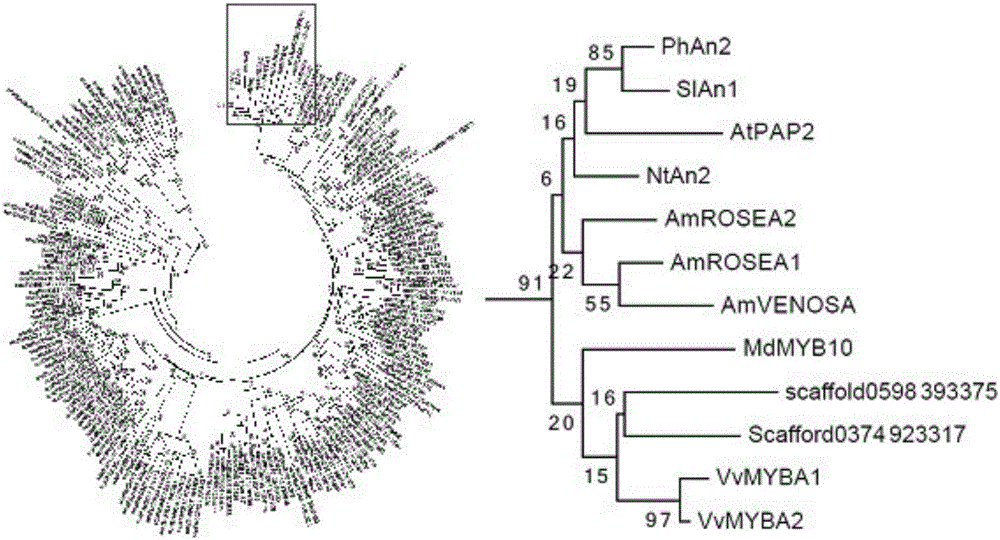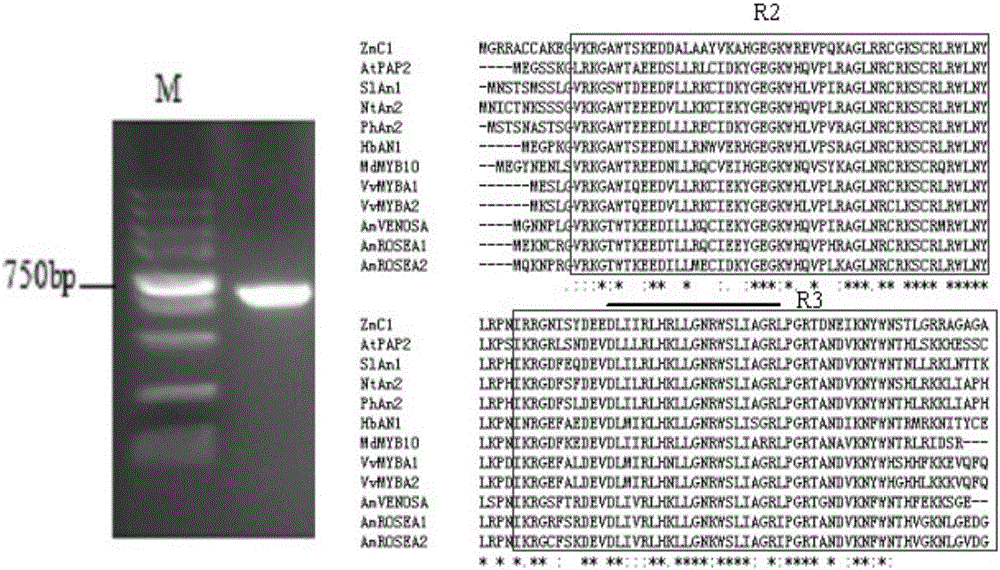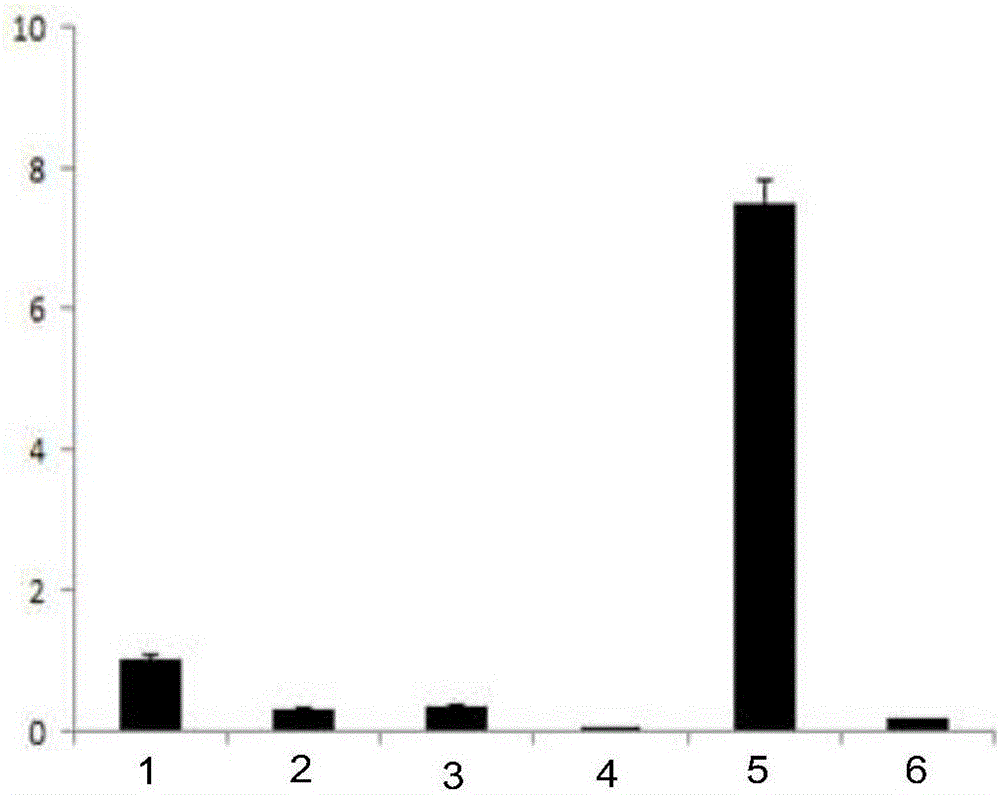Transcription factor capable of regulating rubber tree anthocyanin synthesis and encoding gene and application thereof
A technology encoding genes and transcription factors, applied in the field of molecular biology, can solve the problems of low screening efficiency and achieve good application prospects
- Summary
- Abstract
- Description
- Claims
- Application Information
AI Technical Summary
Problems solved by technology
Method used
Image
Examples
Embodiment 1
[0029] Example 1 Controlling Rubber Tree Anthocyanin Synthesis R2R3-MYB Bioinformatics Discovery
[0030] Using the R2R3-MYB conserved domain as a probe, the Hevea R2R3-MYB transcription factors were retrieved from the Hevea Genome Database, and a total of 177 R2R3-MYBs of Hevea were obtained. Then, Arabidopsis AtPAP2 (AT1G66390.1), dwarf Morning glory PhAN2 (AB982128.1), Tobacco NtAN2 (FJ472647.1), Antirrhinum AmROSEA1 (DQ275529.1), Antirrhinum AmROSEA2 (DQ275530.1), Antirrhinum AmVENOSA (DQ275531.1), Apple MdMYB10 (DQ267896.1 ), potato StAN1, grape VvMYBA1 (AB097923.1), grape VvMYBA2 (AB097924.1) and other 10 R2R3-MYB related to anthocyanin synthesis, and the evolutionary analysis found that the rubber tree scaffold0374_923317 and Scaffold0598_393375 were identified as anthocyanin synthesis Related transcriptional regulators are in the same evolutionary branch ( figure 1 ), it is speculated that the two may be related to the regulation of rubber tree anthocyanin synthesis. ...
Embodiment 2
[0031] Example 2 Cloning and structural domain analysis of R2R3-MYB related to the regulation of rubber tree anthocyanin synthesis
[0032] The scaffold0374_923317 sequence was retrieved from the rubber tree genome database, and the sequence was used as a search sequence to retrieve the leaf transcriptome data of the author's unit, and a gene sequence with a complete ORF was retrieved, and then, specific amplification PCR primers (such as SEQ ID NO.3-4) to amplify its ORF and perform sequencing analysis. As a result, a gene sequence identical to the leaf transcriptome sequence was obtained, with a full length of 618bp, which was named HbAn1. The expression level of the other sequence was very low and was not amplified.
[0033]With Arabidopsis AtPAP2 (AT1G66390.1), Petunia PhAN2 (AB982128.1), Tobacco NtAN2 (FJ472647.1), Antirrhinum AmROSEA1 (DQ275529.1), Antirrhinum AmROSEA2 (DQ275530.1), Antirrhinum AmVENOSA (DQ275531.1), apple MdMYB10 (DQ267896.1), potato StAn1 (AY841127.1)...
Embodiment 3
[0034] Example 3 HbAn1 tissue expression analysis
[0035] Using the cDNA of leaves, dark culture and light culture somatic embryo plant tender stems in four developmental stages of bronze stage, discoloration stage, light green stage and stable stage as template, Premix Ex Taq as reaction enzyme, fluorescent quantitative PCR reaction was performed using LightCycler of Roche Company @2.0 fluorescent quantitative PCR instrument. Fluorescent quantitative primers are HbAn1 primers in Table 1. The reaction program was 95°C for 1min, 95°C for 10s, 58°C for 10s, 72°C for 20s, and 72°C for 1min. The reaction system was 10 μl, including 5 μl 2×Premix Ex Taq, 0.25 μl primer (10 μmol), and 0.5 μl cDNA template. The reaction results were analyzed using LightCycler Software4.05 software. RH8 was used as the internal reference gene, and the standard cDNA and the test samples were set to repeat 3 times. Quantitative analysis found that the expression level of HbAn1 gradually decreased w...
PUM
 Login to View More
Login to View More Abstract
Description
Claims
Application Information
 Login to View More
Login to View More - R&D
- Intellectual Property
- Life Sciences
- Materials
- Tech Scout
- Unparalleled Data Quality
- Higher Quality Content
- 60% Fewer Hallucinations
Browse by: Latest US Patents, China's latest patents, Technical Efficacy Thesaurus, Application Domain, Technology Topic, Popular Technical Reports.
© 2025 PatSnap. All rights reserved.Legal|Privacy policy|Modern Slavery Act Transparency Statement|Sitemap|About US| Contact US: help@patsnap.com



